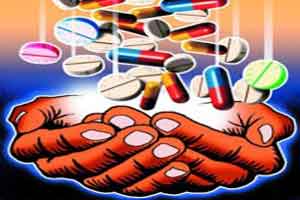- Home
- Medical news & Guidelines
- Anesthesiology
- Cardiology and CTVS
- Critical Care
- Dentistry
- Dermatology
- Diabetes and Endocrinology
- ENT
- Gastroenterology
- Medicine
- Nephrology
- Neurology
- Obstretics-Gynaecology
- Oncology
- Ophthalmology
- Orthopaedics
- Pediatrics-Neonatology
- Psychiatry
- Pulmonology
- Radiology
- Surgery
- Urology
- Laboratory Medicine
- Diet
- Nursing
- Paramedical
- Physiotherapy
- Health news
- Fact Check
- Bone Health Fact Check
- Brain Health Fact Check
- Cancer Related Fact Check
- Child Care Fact Check
- Dental and oral health fact check
- Diabetes and metabolic health fact check
- Diet and Nutrition Fact Check
- Eye and ENT Care Fact Check
- Fitness fact check
- Gut health fact check
- Heart health fact check
- Kidney health fact check
- Medical education fact check
- Men's health fact check
- Respiratory fact check
- Skin and hair care fact check
- Vaccine and Immunization fact check
- Women's health fact check
- AYUSH
- State News
- Andaman and Nicobar Islands
- Andhra Pradesh
- Arunachal Pradesh
- Assam
- Bihar
- Chandigarh
- Chattisgarh
- Dadra and Nagar Haveli
- Daman and Diu
- Delhi
- Goa
- Gujarat
- Haryana
- Himachal Pradesh
- Jammu & Kashmir
- Jharkhand
- Karnataka
- Kerala
- Ladakh
- Lakshadweep
- Madhya Pradesh
- Maharashtra
- Manipur
- Meghalaya
- Mizoram
- Nagaland
- Odisha
- Puducherry
- Punjab
- Rajasthan
- Sikkim
- Tamil Nadu
- Telangana
- Tripura
- Uttar Pradesh
- Uttrakhand
- West Bengal
- Medical Education
- Industry
India invests least on drug discovery

Healthcare risk in India has been on a rise, with the disease burden trends increasing. However, not enough is being done in terms of funding and investment by the country to reduce its dependence on imports for healthcare products.
Consider this; India's per capita expenditure on health research is less than $1. More meager is the figure of 3% which is spent on public health, which forms the backbone of the healthcare risk issue which India continues to tackle.
As further implied in a statement to TOI, Indian Council for Medical Research (ICMR) director general Dr Soumya Swaminathan said that the government must work towards achieving maximum product development capability, and spent most of it on the public health expenditure. This can be further ensured with expanding clinical trial network and, by focusing on multi centric trials.
Again, proven statistically, India has the least investment in healthcare research (drug discovery) of 30% compared to other countries such as Japan, US, and Germany. The call of the time is to invest more resources and invest in high risk long term research to utilise the big potential in India.
As reported by TOI, Dr Soumya Swaminathan said out of $1 billion that the country has been spending annually , just 1% is for healthcare and it is 0.06% of GDP. Of the total amount, only 16% is by not-for-profit institutions and 83% by pharmaceutical industry.
More investment is a must if the country wants to focus on solving health-related issues without depending on other countries, feel researchers at the National Centre for Biological Sciences, the Indian Institute of Science and the Jawaharlal Centre for Advanced Scientific Research (JNCASR).
Echoing this, GJ Samathanam, former advisor, department of Science and Technology, said: "India has a great role to play in novel drug discovery. Our scientists must take up high-risk and high resource-oriented long-term research."
Referring to Bengalurubased Vasan Sambandamurthy and team's single dose solution to cure malaria and two-drug compounds for Ebola developed by Jayanta Haldar and team at JNCASR, scientists argued that more such discoveries will happen only if investment increases.
Consider this; India's per capita expenditure on health research is less than $1. More meager is the figure of 3% which is spent on public health, which forms the backbone of the healthcare risk issue which India continues to tackle.
As further implied in a statement to TOI, Indian Council for Medical Research (ICMR) director general Dr Soumya Swaminathan said that the government must work towards achieving maximum product development capability, and spent most of it on the public health expenditure. This can be further ensured with expanding clinical trial network and, by focusing on multi centric trials.
Again, proven statistically, India has the least investment in healthcare research (drug discovery) of 30% compared to other countries such as Japan, US, and Germany. The call of the time is to invest more resources and invest in high risk long term research to utilise the big potential in India.
As reported by TOI, Dr Soumya Swaminathan said out of $1 billion that the country has been spending annually , just 1% is for healthcare and it is 0.06% of GDP. Of the total amount, only 16% is by not-for-profit institutions and 83% by pharmaceutical industry.
More investment is a must if the country wants to focus on solving health-related issues without depending on other countries, feel researchers at the National Centre for Biological Sciences, the Indian Institute of Science and the Jawaharlal Centre for Advanced Scientific Research (JNCASR).
Echoing this, GJ Samathanam, former advisor, department of Science and Technology, said: "India has a great role to play in novel drug discovery. Our scientists must take up high-risk and high resource-oriented long-term research."
Referring to Bengalurubased Vasan Sambandamurthy and team's single dose solution to cure malaria and two-drug compounds for Ebola developed by Jayanta Haldar and team at JNCASR, scientists argued that more such discoveries will happen only if investment increases.
Next Story


